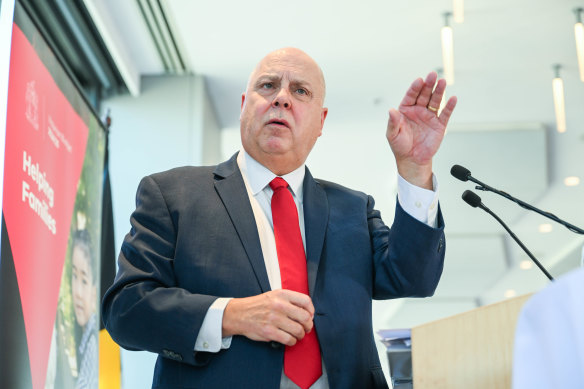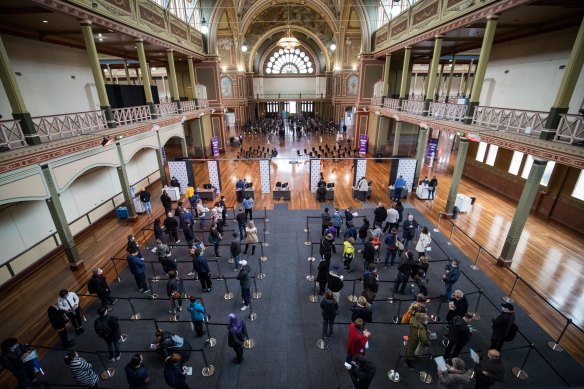- Exclusive
- Politics
- Victoria
- Victorian budget
Victoria’s $12 billion ‘credit card’ for policies not listed in the budget
By Josh Gordon
A little-known fund has handed Treasurer Tim Pallas a $12.1 billion “credit card” to spend on policy promises not listed in the budget and not scrutinised through parliament.
According to a final tally of the 2022-23 budget, Victoria’s so-called Treasurer’s Advance has ballooned to more than 33 times its size a decade ago, when it was about $365 million. In 2022-23 it funded 335 policy promises collectively worth $12.2 billion.

Victorian Treasurer Tim Pallas delivering the state budget in May.Credit: Joe Armao
The figure set aside for next financial year is $12.1 billion.
The advance gives the government easy access to a pool of cash set aside for “urgent” and “unforeseen” contingencies, which in previous years have included natural disasters, legal problems or public health challenges such as the COVID-19 response.
It has prompted claims from the opposition that the government is using the advance to avoid scrutiny of how it is spending taxpayers’ money.
The Treasury’s final financial report for the 2013-14 financial year shows that during its final full year in office, the former Coalition government used the advance to cover 19 policy decisions, worth a total of $364.6 million. It has since had a 3200 per cent increase in 10 years.
The following year the advance again covered the cost of 19 spending decisions, worth about $326 million, before rising to an annual average of about $1.3 billion over the five years to June 2019.
During the COVID-19 pandemic, the use of the advance increased dramatically as the government was forced to deal with billions of dollars’ worth of health-related and economic contingencies.
In the 2020-21 financial year, the government funded about $8.1 billion worth of policy decisions using the advance, rising to about $10 billion the following year.
But with the pandemic now fading into the background, the government has continued to fund hundreds of its policy decisions using the obscure financial mechanism, which effectively acts as a multibillion-dollar approved line of credit.
This month’s budget predicted the state would be in deficit by $2.2 billion in the next financial year, with net debt expected to hit $188 billion by mid-2028 – leaving taxpayers with a $26 million-a-day interest bill.
A state government spokesman said Treasurer’s Advances were routinely used by the government for urgent or unforeseen events, such as natural disasters or emergencies, and to respond to external events such as Commonwealth government decisions.
He said the advance provision had increased to support the government’s response to the pandemic, and it had decreased in the past three budgets.
The latest budget, delivered earlier this month, set aside $12.1 billion for a Treasurer’s Advance next financial year. In last year’s budget, covering the current 2023-24 financial year, the government set aside $13.7 billion, although it now predicts it will spend less than one-third of that amount.
Former Liberal treasurer Michael O’Brien said the huge increase in the use of the advance since the pandemic represented “equal parts laziness and covering up”.
“They don’t want to do the hard work in the budget forecasting where the spending pressures will be,” O’Brien said. “Instead of doing that work, they stick a huge amount in the Treasurer’s Advance. It’s also another way to make the budget far less transparent. It doesn’t give ... any real sense of what the government’s financial priorities are or what the budget position is.”
According to the state Treasury’s final tally of Victoria’s finances for the 2022-23 financial year, 335 spending decisions were paid for using the advance, worth $12.2 billion. That included payments for contingencies such as flood recovery and COVID-19, as well as policy decisions taken during the year to tackle family violence.
However, the tally also reveals billions of dollars of other spending decisions that could be stretching the definitions of “urgent” and “unforeseen”, including $300 million for the government’s controversial Breakthrough Victoria fund, $106.7 million for Labor’s free kinder policy and $642.4 million for the $250 power saving bonus.
The tally also includes $72.4 million for the government’s Big Housing Build, almost $1.2 billion for its level crossing removals, $200.8 million for the Metro rail tunnel, $283.8 million for the Suburban Rail Loop and $58.3 million for commuter car parks.
The Victorian auditor-general found in a November 2020 report that parliament could authorise the use of the Treasurer’s Advance only after any funds were spent. It said because of this, “there should be strong processes and controls over access to this funding and clear accountability to Parliament and the community on its use”.
In response to that report, the Treasury argued a literal definition of “urgent” should not be applied. It suggested that any funding announced by the government not previously sanctioned by parliament should be regarded as urgent. Otherwise, it said, government departments would be in breach of the state’s Constitution because they would effectively be accessing government money with no legal authority.
The Victoria Auditor-General’s Office declined to comment when asked by The Age if it was concerned that the Treasurer’s Advance was being used for spending decisions that stretched the definition of urgent.

During the COVID-19 pandemic, the use of the advance increased dramatically as the government was forced to deal with billions of dollars’ worth of health-related and economic contingencies.Credit: Darrian Traynor
“Our office does not discuss emerging issues or provide views on compliance, except through our reports to parliament,” a spokesperson said.
RMIT emeritus professor David Hayward said there was a need to clarify the purpose of the advance, and whether it was now being used appropriately.
“What appeared to be a reasonable practice arising from the highly unusual COVID period now appears to be standard, but we don’t have an explanation why,” he said. “They are effectively using a very big credit card that is being used to pay for all sorts of things you wouldn’t expect.”
Opposition finance spokeswoman Jess Wilson said the government’s growing reliance on emergency funding to pay for basic education, health and infrastructure services highlighted the dire state of Victoria’s finances.
“Treasurer’s Advances are meant to be for urgent and unforeseen expenses, not core government business,” Wilson said. “Labor’s growing abuse of this funding mechanism undermines financial transparency and accountability.”
Get the day’s breaking news, entertainment ideas and a long read to enjoy. Sign up to receive our Evening Edition newsletter here.